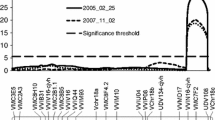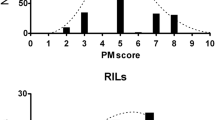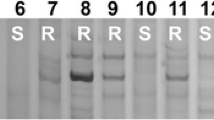Abstract
The aim of this study was to investigate the inheritance of powdery mildew disease and to tag it with a DNA marker to utilize for the marker-assisted selection (MAS) breeding program. The powdery mildew resistant genotype Falloner and susceptible genotype 11760-3ER were selected from 177 genotypes by heavy infestation of germplasm with Erysiphe pisi through artificial inoculation The F1 plants of the cross Fallon/11760-3 indicated the dominance of the susceptible allele, while F2 plants segregated in 3: 1 ratio (susceptible: resistant) that fit for goodness of fitness by χ2 (P > 0.07), indicating monogenic recessive inheritance for powdery mildew resistance in Pisum sativum. A novel RAPD marker OPB18 (5′-CCACAGCAGT-3′) was linked to the er-1 gene with 83% probability with a LOD score of 4.13, and was located at a distance of 11.2 cM from the er-1 gene.
Similar content being viewed by others
References
Rakshit, S., Mohapatra, T., and Mishra, S.K., Marker Assisted Selection for Powdery Mildew Resistance in Pea (Pisum sativum L.), J. Genet. Breed., 2001, vol. 55, pp. 343–348.
Lande, R. and Thompson, R., Efficiency of Marker Assisted Selection in the Improvement of Quantitative Traits, Genetics, 1990, vol. 124, pp. 743–756.
Ek, M., Eklund, M., and Von-Post, R., et al., Microsatellite Markers for Powdery Mildew Resistance in Pea (Pisum sativum L.), Hereditas, 2005, vol. 142, pp. 86–91.
Dixon, G. R., Powdery Mildew of Vegetables and Allied Crops, Powdery Mildew, Speaure, D.M., Ed., Academic Press, 1987.
Nisar, M., Ghafoor, A., Khan, M.R., and Qureshi, A.S., Screening of Pisum sativum Germplasm against Erysiphe pisi Syd., Acta Biol. Cracoviensia, Ser. Botanica, 2006, vol. 48, no. 2, pp. 33–37.
Janila, P. and Sharma, B., RAPD and SCAR Markers for Powdery Mildew Resistance Gene er in Pea, Plant Breeding, 2004, vol. 12, no. 2, pp. 271–274.
Harland, S.C., Inheritance of Immunity to Powdery Mildew in Peruvian Forms of Pisum sativum, Heredity, 1984, vol. 2, pp. 263–269.
Heringa, R.J., Van Noveland, A., and Tazelaar, M.F., Resistance to Powdery Mildew (E. polygoni) in Peas (P. sativum L.), Euphytica, 1969, vol. 18, pp. 163–169.
Kumar, H. and Singh, R.B., Genetic Analysis of Adult Plant Resistance to Powdery Mildew in Peas (Pisum sativum L.), Euphytica, 1981, vol. 30, pp. 147–151.
Fondevilla, S., Carver, T.L.W., Moreno, M., and Rubiales, T., Identification and Characterization of Sources of Resistance to Erysiphe pisi Syd. in Pisum ssp., Plant Breeding, 2007, vol. 126, pp. 113–119.
Tiwari, K.R., Penner, G.A., and Warkentin, T.D., Inheritance of Powdery Mildew Resistance in Pea, Canad. J. Plant Sci., 1997, vol. 77, pp. 307–310.
Nisar, M. and Ghafoor, A., Inheritance Studies of Pisum sativum F1, F2 and F3 Generation Based Morphological Traits and Selection of High Yielding Powdery Mildew Resistant Lines, Mol. Plant Breeding, 2009, vol. 7, no. 2, pp. 1–6.
Kang, H.W., Cho, Y.G., Yoon, U.H., and Eun, M.Y., A Rapid DNA Extraction Method for RFLP and PCR Analysis from a Single Dry Seed, Plant Mol. Biol. Reporter, 1998, vol. 16, pp. 1–9.
Lander, E.S., Green, P., Abrahamson, J., et al., Mapmaker: An Interactive Computer Package for Constructing Primary Genetic Linkage Maps of Experimental and Natural Populations, Genomics, 1987, vol. 1, pp. 174–181.
Arshad, M., Inheritance of Genetic Traits and Breeding Methodologies Based of Various Generation in Blackgram (Vigna mungo (L.) Hepper), Quaid-I-Azam Univ. Islamabad, 2004, pp. 1–4.
Fondevilla, S., Avila, C.M., Cubero, J.I., and Rubiales, D., Response to Mycosphaerella pinodes in a Germplasm Collection of Pisum ssp. in Pisum ssp. Plant Breeding, 2005, vol. 124, pp. 313–315.
Pierce, W.H., Resistance to Powdery Mildew in Peas, Phytopathology, 1948, vol. 3, p. 21.
Gupta, M.D., Inheritance of powdery mildew resistance in pea (Pisum sativum L.) PhD Thesis, New Delhi: Indian Agric. Res. Inst. 1987.
Vijayalakhmi, S., Yadav, K., Khushaha, C., et al., Identification of RAPD Markers Linked to the Rust (Uromyces fabae) Resistance Gene in Pea (Pisum sativum L.), Euphytica, 2005, vol. 144, pp. 265–274.
Ribaut, J.M., Jian, C., and Hoisington, D., Simulation Expertise on Efficiencies of Gene Introgression by Backcrossing, Crop Sci., 2002, vol. 42, pp. 557–565.
Okubbara, P.A., Inglis, D.A., Muehlbauer, F.J., and Coyne, C.J., A Novel RAPD Marker Linked to the Fusarium Wilt Race 5 Resistant Gene (Fwf) in Pisum sativum, in Pisum Genetics, 2002, p. 34.
Yu, Z., Liqiong, L., Huan, L., et al., RAPD Markers in Diversity Detection and Variety Identification of Tibetan Hulless Barley. Plant Mol. Biol. Rep., 2002, vol. 20, pp. 369–377.
Author information
Authors and Affiliations
Corresponding author
Additional information
The article is published in the original.
Rights and permissions
About this article
Cite this article
Nisar, M., Ghafoor, A. Linkage of a RAPD marker with powdery mildew resistance er-1 gene in Pisum sativum L.. Russ J Genet 47, 300–304 (2011). https://doi.org/10.1134/S102279541102013X
Received:
Accepted:
Published:
Issue Date:
DOI: https://doi.org/10.1134/S102279541102013X




